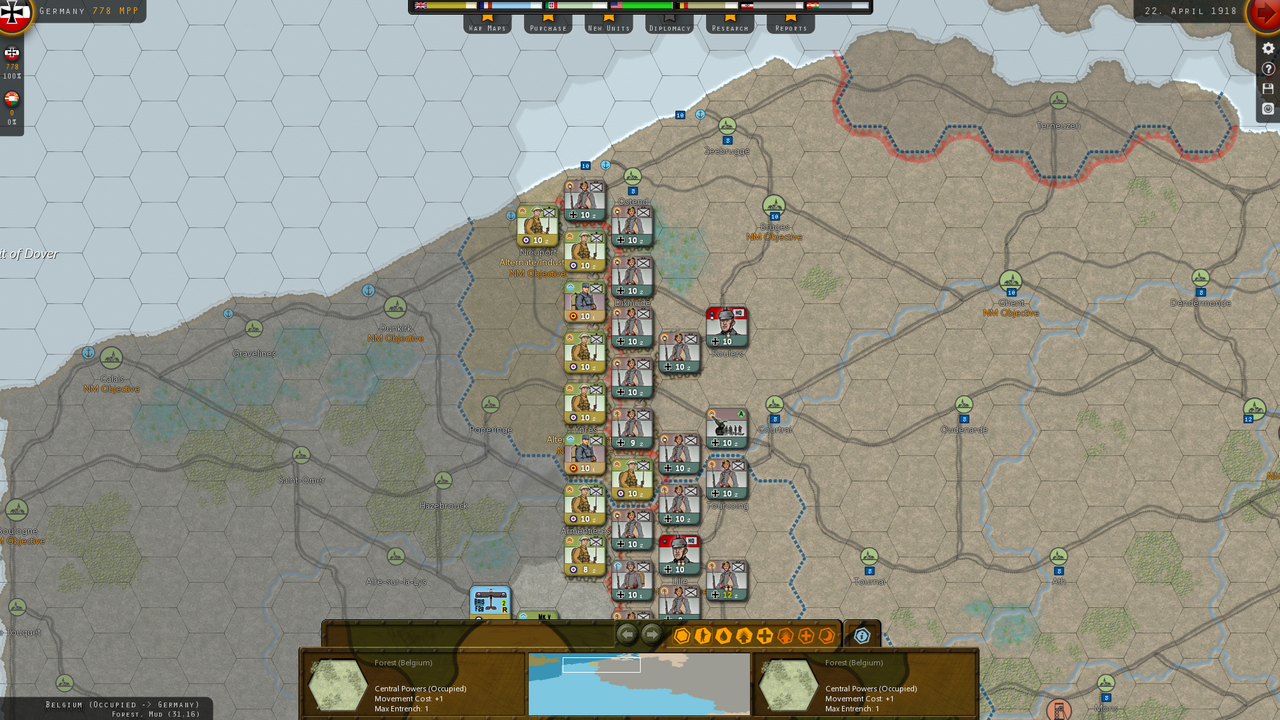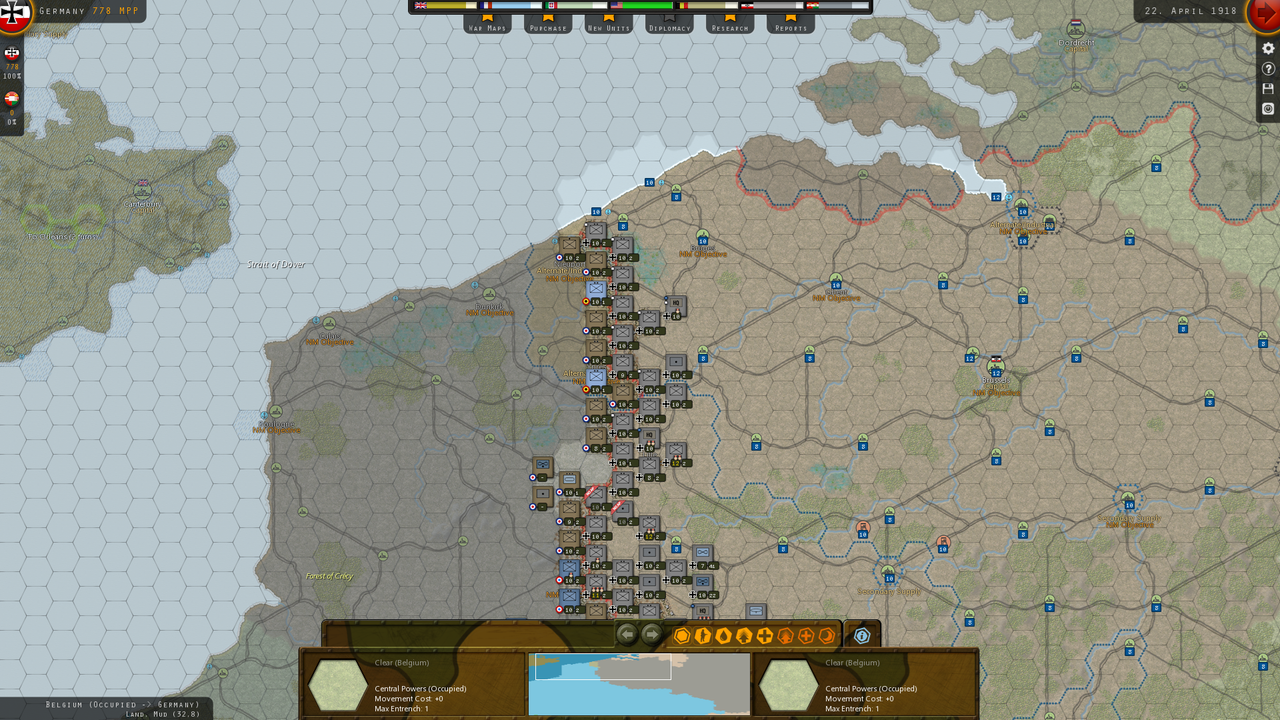My "War in Europe" Axis campaign is going off the rails. Amusingly similar to real life, I tried really hard to take Malta but failed. I lost paratroopers in Crete and had to spend precious Germoids to help Italy in mainland Greece. I put a little too much support into Africa so I took Egypt, but now my resources are strained elsewhere. I hit the gates of Moscow/Leningrad, but lost steam. HUGE reserves of Russians started appearing so now in mid-'42 I'm doing an active retreat to see if I can stabilize the line as there are large gaps between my spearheads. I'm probably not using the HQ's as well as I should, there's a lot of mechanics under the hood with these things.
The partisans are pretty well simulated. There's a constant war in the backline, and a lot popping in Russia/Yugoslavia as expected.
I'm tempted to just get all these games to try them out. It's a surprisingly addictive beer'n'pretzels type of fun.
Yes the games are great fun and really good at the strategic and operational but imperfect tactically such as ACW. The newest in the series SCWITP just came out:
They change up the systems? Sea battles seem a little weak, so I'm thinking it can't be a 1:1 with a Pacific coat of paint.
They have added improvements to naval yes:
As this question has been raised, I thought it might be useful to make a post explaining how this campaign differs from the Pacific aspect of our WWII: World at War game.
Note that while the engine for WWII: World at War will in due course be upgraded, for the most part the campaign changes listed below will not be added to the official campaigns.
1) Japan’s allies are much more heavily featured:
https://www.matrixgames.com/forums/viewtopic.php?f=11997&t=403321
2) China is more divided and troops will be needed both to maintain internal order and to fight the enemy:
https://www.matrixgames.com/forums/viewtopic.php?f=11997&t=404156
3) French forces in Indochina can now revolt against the Japanese.
4) The Doolittle raid can now be launched.
5) Ports on islands now provide less supply to naval units, making things more realistic.
6) A new research category has been added called Naval Construction, allowing for port supply on small islands to be increased (think Seabees).
7) Having naval superiority in “The Slot” is now important to winning the battle for control of Guadalcanal in the Solomons.
8) There are now Battleships and Super Battleships, the latter being for ships like the Yamato and the Iowa class.
9) Japan’s Light Cruisers and both side’s Super Battleships have an increased spotting range at sea to reflect their use of spotting planes.
10) There are no Long Range Amphibious Transports in this campaign, so invasions require more planning and will be more effective the less time the troops spend at sea – making limited island hopping possible, while rendering long range missions effectively impossible.
11) Coupled with the above, unless they capture Hawaii, Japanese units to the east of the island will suffer penalties due to being far from home.
12) Naval units now have significantly increased Zones of Control, making it easier to protect vulnerable ships such as your Carriers and invasion forces.
13) Additionally, naval retreat ranges and the chances of ships retreating have been increased significantly, improving the “feel” of naval battles.
14) A second new research category is Submarine Warfare. Neither the US nor Japanese submarine fleets engaged in many attacks on merchant shipping early in the war, and only the US began doing so as the war progressed.
Consequently to reflect this, both sides can now change their Submarine units’ doctrines as the war progresses, increasing both the size and raiding capabilities of their submarine fleet in order to better target enemy convoy routes.
15) Airfields have been introduced to many Pacific islands, and units occupying them benefit from increases in their range and effectiveness. This makes these useful places to station Maritime Bombers to watch for enemy shipping. It does of course also make them important places to fight over, and to give just one example: Henderson Field does tend to be very intensely fought over, just as it was in real life.
16) Victory Conditions will change as the campaign progresses, and both sides should have a good chance of winning. Japan does not need to conquer everything in order to win, so it can make for a high intensity experience if they get to close to victory before the US has fully got its amphibious invasion forces into position to make a difference.
17) Australia is now a Major power.
18) Communist China can expand as the war progresses should the conditions allow it.
19) If the Allies can capture Lorengau then Rabaul can be effectively isolated.
20) Strategic Bombers are less effective.
21) There are lots of new Decision to take based on new research into the war, and this campaign also comes with a 40-page Strategy Guide full of useful information, including a list of all the National Morale locations with coordinates.
22) The historical Pop Ups can be turned off by going to: Options -> Advanced -> Scripts -> Decision (it's the one right at the bottom) and turn off DE 163 (it's the one right at the top).
23) Submarines' base attack values are lower, therefore they will need upgrading if they are to prove useful as fleet auxiliaries, although Japan does start with a higher level of research in order to reflect the quality of its Long Lance torpedoes.
24) Australia has the option to invest in Coast Watchers who will provide intelligence reports on Japanese dispositions.
25) If the US does want to use Atomic Bombs, it will need to invest in them at an earlier date, planning ahead rather than paying for them when they are used.
Hopefully I have captured all the important differences here, because after working on the Pacific for months on end and making literally hundreds of changes before beta even began, it can be hard to remember everything. I will of course update this if it does transpire that I missed something important, so please tell me if I have.















